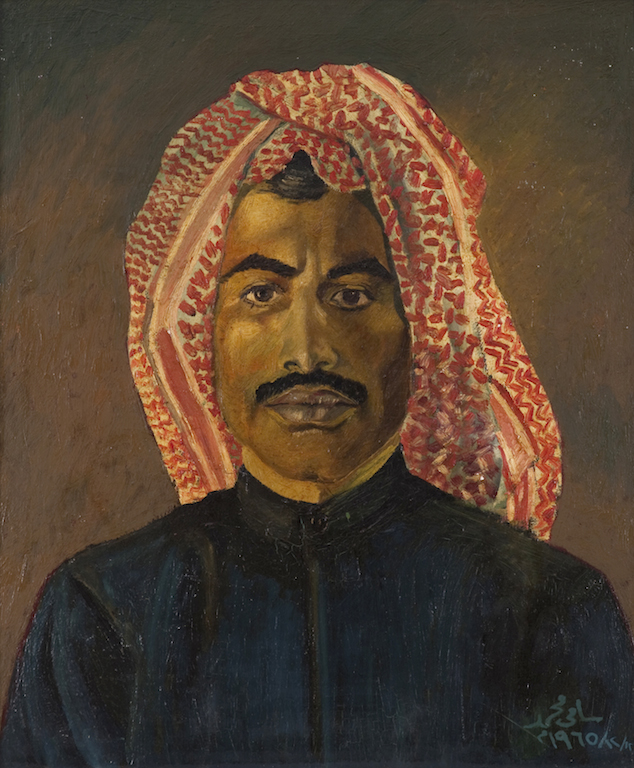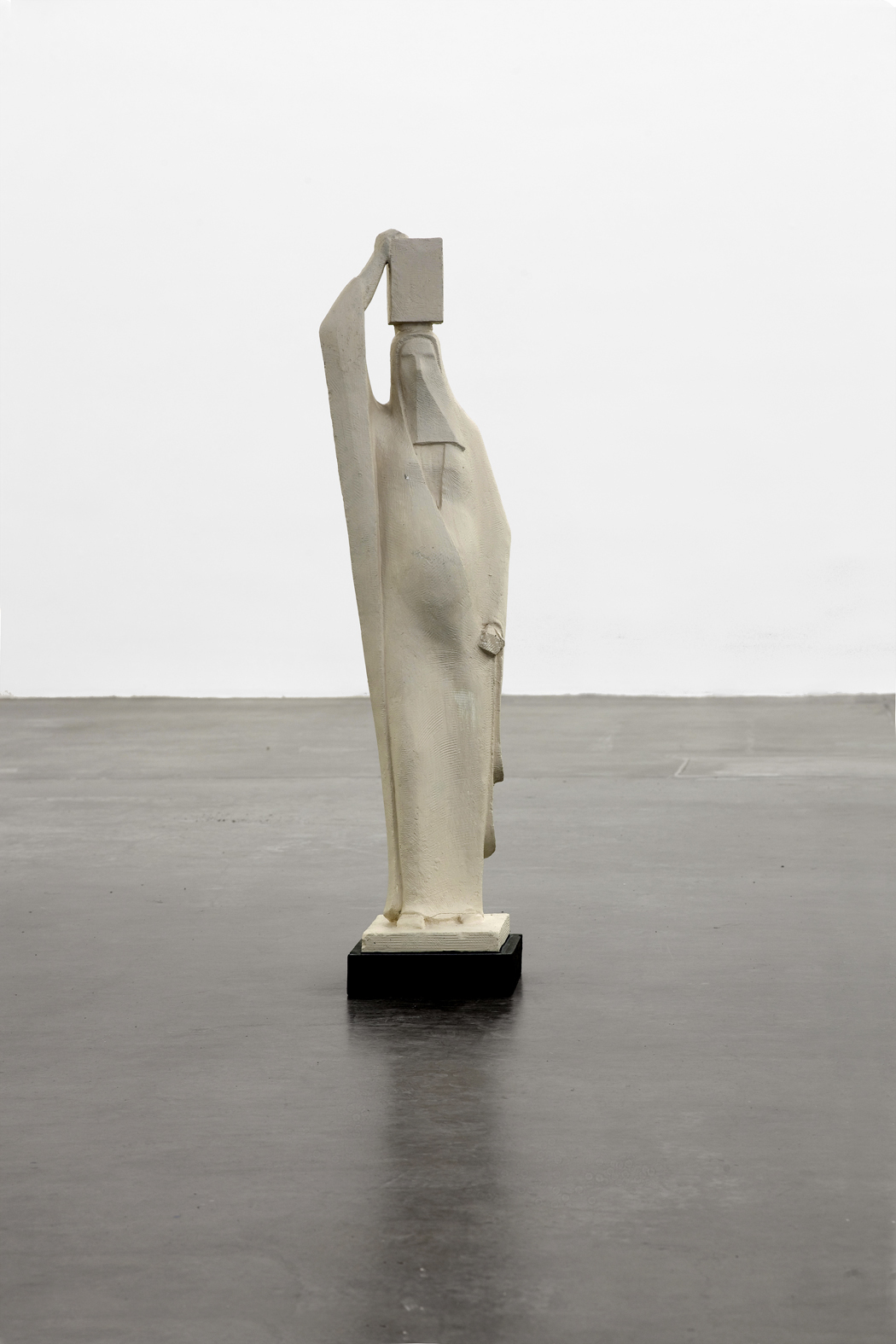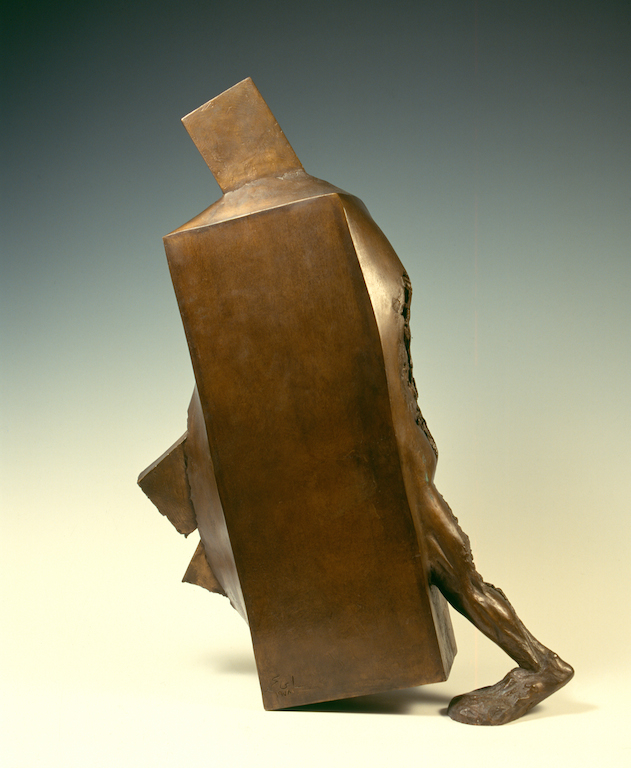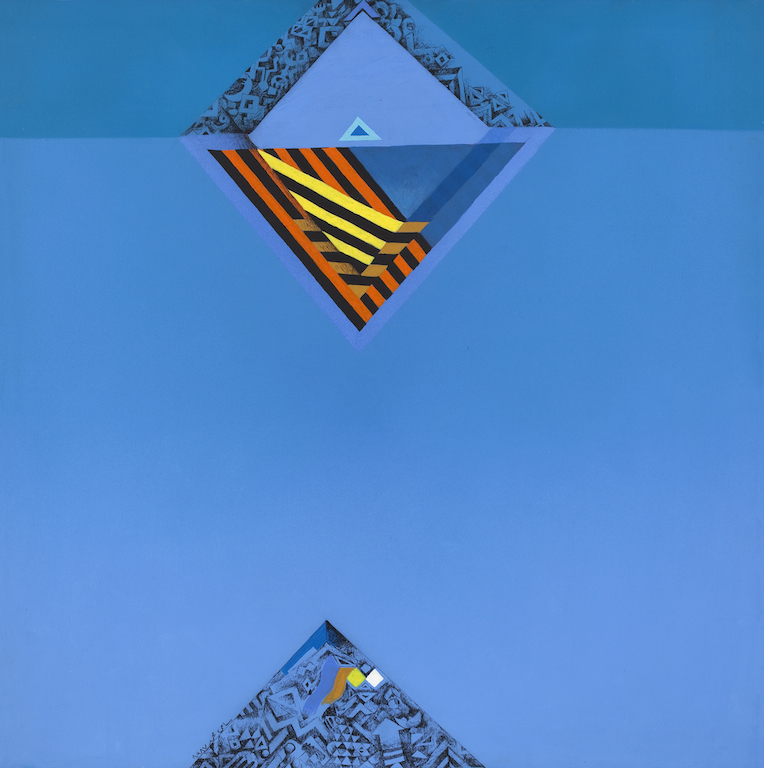Within a few years of joining Kuwait’s Free Atelier in 1959, Sami Mohammad created a collection of paintings and sculptures that would determine the direction of his art over the next five decades. As one of the studio’s first artists, he was given a stipend by the Kuwaiti government that allowed him to focus on developing his artistic practice fulltime. The groundbreaking art space and its associated programs provided Mohammad and his colleagues with an ideal setting—a place where they could liberally work with various media while receiving artistic training outside the rigid directives of an academy.
The benefits of the open-studio environment are evident in the range of work Mohammad produced during this time. Small ceramic busts and figurines, a statue of twelfth-century philosopher Ibn Rushd, and a series of oil paintings are among a number of examples from this early period of his creative output. As the artist explains in a 1994 monograph, the unifying concept of these works is the exploration of man, love and freedom—a causal thread found throughout his oeuvre. During the initial stage of his art making, space and its impact on the body became a starting point for his career-long treatise on the modern condition of man. Using a combination of intricate symbolism and formal experimentation, Mohammad’s treatment of humanist themes has been realized through descriptions of particular settings, as he outlines how to break free from their limits. The figure in Mohammad’s works—whether alluded to in abstract paintings or trapped between the three-dimensional, geometric planes of mannerist sculptures—is often poised to transcend the given moment.
In the beginning, Mohammad used several stylistic approaches when depicting human subjects or aspects of daily life. In a 1965 portrait of a man, for example, the artist combines realist and expressionist techniques as he focuses on the chiseled face of a contemplative sitter. The figure’s loosely painted clothes—a red and white keffiya and a black thawb—frame his face against an olive green background, making it the focal point of the composition. Mohammad marks the model’s absorbed state by contrasting the warm glow of highlights with the coolness of shadows, and accentuates his immovable gaze by detailing his features with thickly executed lines and brushstrokes. Color is similarly used in Brass, which he painted the same year. Blue silken textiles serve as the backdrop to a modest still life, yet as light falls across weathered domestic items from an unseen source the arrangement seems to shine, transforming the ordinary scene into a brilliant display of golden hues while incorporating the component of time.
 [Study Model, 1965. A portrait of Kuwaiti artist Abdulhamid Ismail. Image copyright Sami Mohammad. Courtesy of Contemporary Art Platform.]
[Study Model, 1965. A portrait of Kuwaiti artist Abdulhamid Ismail. Image copyright Sami Mohammad. Courtesy of Contemporary Art Platform.]
With the plaster sculptures, such as The Water Carrier (1966), Mohammad rendered his subjects with partial abstraction, allowing the angular outline of the body in motion to determine negative space. The figure’s rounded forms are shown behind sharp lines that travel from the bottom seam of a long, flowing abaya to her softened shoulders. At the base of the sculpture is a square platform, which fixes the woman to her environment. The container she carries on her head equalizes the implied gravity of the low stand, and frames her between two points. In other works from this period, the artist depicts the shifting position of the figure through subtle contours and an emphasis on mass, with minimal reference to the physical features of the subjects. Over time and through a range of media, this representation of movement would gradually lead to the development of his later sculptures including the Boxes, Shackled, and Penetration series. Here the artist translates force into formal values and outlines the social factors impeding humankind by constraining his freestanding figures with sculpted facets. Although Mohammad’s paintings, drawings, and sculptures can be viewed as offshoots of his art that have evolved through concentrated trials, these different strands should be comparatively read when seeking to understand aspects of his practice. The artist’s sculptures and paintings, for example, have been mutually informed since his days at the Free Atelier, when he effortlessly moved between different styles and media. In order to contemplate his decades-long productivity in painting, particularly in his unparalleled Al Sadu series, one must first review his journey with sculpture, where profound insights into space as actively defining perception can be found.
 [The Water Carrier, 1966. Image copyright the artist. Courtesy of Contemporary Art Platform.]
[The Water Carrier, 1966. Image copyright the artist. Courtesy of Contemporary Art Platform.]
 [The Rush, 1978. Image copyright the artist. Courtesy of Contemporary Art Platform.]
[The Rush, 1978. Image copyright the artist. Courtesy of Contemporary Art Platform.]
Upon encountering Mohammad’s plaster, wood and bronze works, the viewer is not only presented with a visual description of a particular moment in time or setting but also an art object that redefines the space in which it is shown. Just as the physical dimensions of the sculpture alter the viewer’s immediate environment, the act of viewing occurs in relation to the entire body. Such considerations of form are often associated with the twentieth-century minimalist art movement, which was partially inspired by Maurice Merleau-Ponty’s The Phenomenology of Perception (1945). The notion of an artwork as presenting new conceptualizations of space, however, was originally a hallmark of modern art, beginning with the paintings of Paul Cezanne. In his work, Mohammad has built on this distinctly modern approach by including observations of how the body becomes a reflection of psychosocial experience.
Among the artist’s early works, The Sad Man (1966) displays his initial synthesis of what Herbert Read described as the two offshoots of modern sculpture: “pure form” which aims to create “a spatial reality” through investigations of material properties; and the humanist tradition renewed by Auguste Rodin, who urged fellow artists to “conceive form in depth.”[1] Created while in Egypt, after receiving a scholarship from the Kuwaiti government to study abroad, The Sad Man indicates Mohammad’s preliminary research of the region’s art historical forms. A small figure rests on a square plinth; seated with his knees tucked into his body, he shields his face from view with tightly crossed arms. The subject of the sculpture seems to be a young man. The work is executed from black basalt rock, a material that is lustrous when polished, and shaped with round yet well-defined edges. In its composition and material, the sculpture is reminiscent of Sumerian and Pharaonic statues. Black basalt rock can be found in the Arabian Desert and the Sinai Peninsula, and was used by artists to create portraits of rulers or noblemen. Mohammad referenced specific examples of Ancient Egyptian sculpture when creating the work. Seated figures from the final phase of the Pharaonic age are posed in similar frontal positions; barefoot and in robes, they hold tablets commemorating the sitter. Mohammad alters the meaning of the ancient image by using the pose of the regal subject for an ordinary, modern protagonist, dressed in simple shoes, plain pants, and a collared shirt with rolled sleeves. Although the traditional forward-facing position is replicated, signaling eternality, Mohammad’s figure is incapable of addressing the viewer; overcome by melancholy, he retreats into a quiet moment.
.jpg) [The Sad Man, 1966. Image copyright the artist. Courtesy of Contemporary Art Platform.]
[The Sad Man, 1966. Image copyright the artist. Courtesy of Contemporary Art Platform.]
Mohammad continued to explore the imagery of everyday life while living in Egypt from 1966 to 1970, yet the works he produced at the College of Fine Arts in Cairo reveal a conceptual shift. There he trained with artist Gamal El Sagini, who is recognized for introducing expressionism to modern Egyptian sculpture. El Sagini chronicled Egypt’s revolutionary period with allegorical representations of political themes, often with emphatic messages and accessible symbolism.[2] A decade before Mohammad arrived in Egypt, the local art scene had been transformed by numerous schools of art that equated modernism with the breakdown of social barriers, most importantly the need to chart life across all sections of Egyptian society. While in Cairo, he produced a body of work that reflects the social realist leanings of the period, an approach to representation that was employed in artistic circles across the Arab world. In style and formal considerations such as proportion and volume, Mohammad’s The Female Drummer (1966), Worship (1966), and The Sleeping Woman (1967), exhibit a transnational aesthetic. In The Sleeping Woman, for example, the evocation of space that weighs on a peasant dozing in a seated position appears in the late 1960s paintings of Syrian modernist Louay Kayyali.
The oil on canvas portraits Mohammad painted in Egypt also indicate his investigation into the body as a site where traces of a given time and place emerge. Working through several methods, he depicted his subjects with painterly techniques, allowing his brushstrokes to intensify the emotive content of compositions. In a 1968 untitled study, a partially nude model is shown leaning on a chair, her body turned to one side as she rests on her arm. Mohammad emphasizes his protagonist’s withdrawn posture by elongating her neck with a series of brushstrokes that extend from the curve of her shoulder to the back of her head, over areas of deep brown flesh tones punctuated by orange highlights. Other areas of her body, such as her raised forearm bathed in light or her face in profile are also rendered with abstraction, transforming her frame into a series of planes. The woman’s features adopt the representational details of ancient art such as the black, hollow eyes and enlarged hands of Sumerian figures. The artist’s appropriation of these signs situates his figure within an unbroken chain of history, and revives their semiotic meanings in a new context—a type of sampling employed by modern artists from Egypt to Iraq. The wide eyes of Sumerian ceremonial statues are said to signify permanent wakefulness, indicating the importance of devotional practices to worshipers. In Mohammad’s painting, the figure’s darkened eyes appear to signal an unshakable state of distress, while her stylized hands—usually shown clasped at the chest as an indication of piety—are painted apart, one loosely hangs over the back of the chair while the other grips a small side table as though in need of a stabilizing force.
Although portraiture constituted the bulk of the artist’s work in Egypt, a 1968 street scene titled A View from the Balcony further demonstrates how Mohammad adapted the properties of sculpture to conceive of space in two-dimensional form. In the foreground of the composition, a man passes in front of a blue car as he walks towards a sidewalk illuminated by streetlamps. The scene is framed with the balconies of apartment buildings and the greenery of overgrown trees that provide a sense of scale, while determining the path of the figure. The edifices are painted as stacked blocks, dividing the composition in three, while directing the viewer’s gaze from the foreground rendered in the darkness of night to a cloud covered, blue sky. This disjunction suggests that different moments in time have been joined to create a single reality. In place of offering a static image, in which an instant is observed, the artist perceives a continuous passage of time—the only still elements of the scene are the structures that situate it. The figure, while relatively small, seems to travel with the motion of billowing clouds and rustling trees as his guide. The volume and mass of Mohammad’s sculptures, which are heightened by intimations of infinite time, were transferred to his paintings as formal properties that locate figures in space.
In A View from the Balcony, Mohammad’s protagonist exceeds the boundaries of his built environment through deliberate motion, a metaphor for transcendence that appears to have directed the underlying thesis of his subsequent paintings and sculptures: the capability of man to surpass what is constructed, from political conditions to social structures. The paintings Mohammad created after returning to Kuwait in 1970 brought together his previous findings. Careful renderings of old houses and neighborhoods with impressionist markings feature a lone woman or man traveling through sunlit quarters. The artist’s realism in these works includes an emphasis on sharp lines delineating architectural details in addition to the central planes that establish the perspective of each composition, resulting in meditations on shape and color. The immediate years that followed were marked by investigations in sculpture and painting with the curvature of natural contours as the basis for abstraction. After training in the United States—where he joined the Johnson Atelier Technical Institute of Sculpture in Princeton, New Jersey in 1974—he resettled in Kuwait and executed a set of teakwood sculptures that imagine the maternal body as a series of broad, interwoven forms, the stylization of which implies enduring strength and cyclic transformation. The Curve paintings ushered in the second phase of Mohammad’s art, and quickly progressed as a separate body of work. Simplified compositions exploring the dynamism of floating shapes allowed the artist to transition to complete abstraction while maintaining a focus on volume, mass and proportion in relation to space. Intersecting, solid black lines make up suspended shapes that drift across contrasting color fields in a meeting of automatism and suprematist fundamentals. The series provided a template for the artist’s Al Sadu project, which includes his most accomplished collection of paintings to date, among two hundred works in various media.
Offering a theoretical evaluation of the origins of Kuwaiti society and culture, Mohammad’s Al Sadu series reinterprets the symbolism of Bedouin textile art by deconstructing its patterns and isolating its essential parts. As Zahra A. H. Ali notes in an in-depth study of the project, Mohammad’s interest in the utopian ideology at the center of nomadic society motivated his appropriation of its designs. The series takes its name from a wool weaving tradition native to the Arabian Peninsula, where triangular motifs are integral to the visual culture of Bedouin populations and are passed on from one generation of women to the next through verbal descriptions and instruction. Pictorially, the imagery of alsadu ornamentation evokes the desert environment as it registers the routes of passing tribes, and provides a type of informal documentation for a community that has otherwise relied on oral lore to sustain its culture. Wide areas of earth tones serve as the backdrop to geometric patterns that alternate in color and shape, depicting the forward motion of migrating figures. Ali also observes that this compositional configuration represents the gendered spaces of Bedouin society specifically the interiors of tents, the realm of domesticity overseen by women that provides a momentary sense of security and permanence. [3] In his paintings, Mohammad keeps the semiotic structure of alsadu wool weaving intact but opens its spatial domain by allowing its patterns to deviate from linear paths.
 [Yellow and Black, 1987. Image copyright the artist. Courtesy of Contemporary Art Platform.]
[Yellow and Black, 1987. Image copyright the artist. Courtesy of Contemporary Art Platform.]
When the artist began the series in 1979, he gradually deciphered the symbolism of the aesthetic for the viewer by depicting alsadu textiles as recognizable items, even if shown in pieces amid color-saturated compositions. In 1982, he created numerous portraits in which pensive protagonists are set against free-falling shapes contained in vertical, gravitational planes, perhaps pointing to the collective unconscious. As the series grew, Mohammad increasingly turned to abstraction, painting wandering formations that hover over seas of deeply painted hues, often with a perspective from above. Triangles, circles, and zigzagging and irregular objects move in unison, as each is a key element of a larger whole. Adding the sweeping lines and dramatic curves of his previous series while injecting brilliant color, the artist envisions a reality in which individual forces coalesce in limitless space and time, signaling the birth of new forms.
*The above essay appears in the accompanying publication of Sami Mohammad: A Retrospective, the first-ever survey of the artist`s extensive career. Examining more than five decades of work, the retrospective is curated by Abed Al Kadiri and will be on view at Contemporary Art Platform in Kuwait from 15 March to 14 June. The catalogue also includes essays by the curator and Dia Azzawi, and an interview with the artist by Sultan Sooud Al Qassemi.
Footnotes
1. Herbert Read, Modern Sculpture: A Concise History (London: Thames & Hudson, 1964).
2. Lilane Karnouk, Modern Egyptian Art: 1910-2003 (Cairo: American University of Cairo Press, 2005).
3. Zahra A. H. Ali, Sami Mohammad and the Semiotics of Abstraction: Kuwaiti Folk Art as Muse (Al-Mansouria: Center for Research and Studies on Kuwait, 2004).